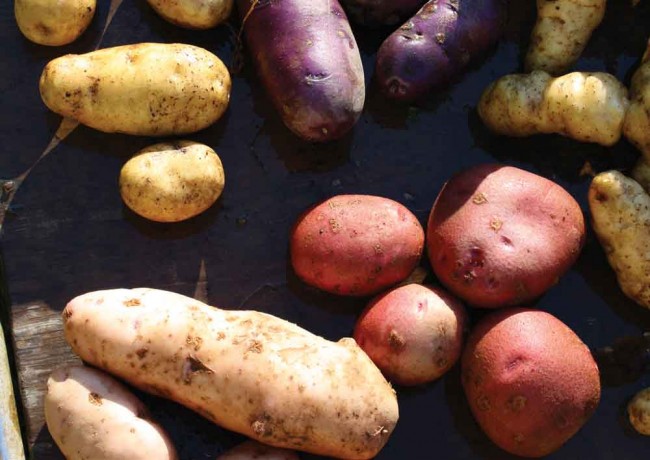
Photo Credit: Norma Kerby
Super Spuds: Heritage potatoes return to the North
No one was eating the mashed potatoes. It was a perfect supper: roast, gravy, golden squash—except for the potatoes. There they sat, steaming in the serving bowl, their blue colour complementing the red of the cranberry jelly. “Potatoes should be white,” one of my disgruntled children muttered.
It took me a while to convince my family that potatoes can come in different hues and flavours. Most North Americans, raised on white, starchy potatoes, are reluctant to consider eating one of the hundreds of heirloom varieties available globally. They are missing a great food adventure. If they are gardeners, they may also be missing the opportunity to grow plants that are prolific producers and adapted to our northern climate.
The potato, domesticated for at least 8,000 years, originated on the cool uplands slopes of the South American Andes. A member of the nightshade family (Solanaceae) and related to tomatoes, the common potato (Solanum tuberosum) was imported to Europe by the Spanish Conquistadors during the early 1500s. The potato is the world’s third most consumed food crop after rice and wheat. From this one species arose hundreds of potato varieties, grown in a wide variety of climates and soil types and used for an even broader selection of fresh and processed food products.
How could one species have so much genetic variation? According to CIP, the International Potato Center based in Lima, Peru, Andean farmers traditionally grew at least 4,300 varieties of S. tuberosum at different elevations and under different conditions throughout the mountains. Over thousands of years of domestication, potatoes were selected for a wide range of taste, texture, shape and colour. As potatoes are able to flower and produce viable seeds, those imported to Europe grew into genetically variable offspring. Enterprising farmers noted the differences and selected potato varieties with desirable characteristics.
In less than 500 years after the common potato left the Andes, the outcome of agricultural selection was an amazing array of potato varieties, each adapted to the growing conditions of a specific location and possessing a particular colour, taste, hardiness, maturity time and ability to be stored. Potato tubers are clones of their parent plants. Saving tubers to plant the next year guaranteed that identical potatoes could be grown again. Once a variety was selected, it could be propagated and shared amongst neighbouring farmers.
When European immigrants moved to northern BC, they brought with them their favourite potato varieties, whose ancestors had originated in the New World hundreds of years before. Other varieties arrived through commercial sellers, such as the T. Eaton Company and the Dominion Seed House. It was from this smorgasbord of cultivars that our regional heritage potatoes were derived. A few of these variants are still cultivated in northern gardens, but most heirloom potato varieties are being revived through seed companies specializing in organic and heritage potatoes. By checking historic documents and antique seed catalogues, one can gain a good understanding as to which of these heirloom varieties were successful in northern BC.
Prior to World War II, farmers classified their potato cultivars in three ways: days to maturity, texture and skin colour. As potatoes were often the primary food source for homesteaders, maturity time was very important. Common varieties included early season potatoes (such as Early Six Weeks, Early Ohio and Early Rose), mid-season potatoes (Irish Cobbler) and late season varieties (Russet Burbank and Delaware).
Heirloom potatoes were also divided into two main texture categories: floury or starchy potatoes, such as the Russet Burbank potato, and waxy or dense potatoes, such as the various Fingerling potatoes. Waxy potato varieties store well and, in a stew, maintain their shape. They also tend to be good winter keepers. A starchy potato can be mashed and fluffed with ease. Historically, floury potatoes were not only used for human consumption, they were also cooked for livestock feed, especially for swine.
Colour was also important in classifying potato varieties. In an era where white-fleshed potatoes were the fashion, most northern potatoes were either red with white flesh (such as the popular Early Rose) or brown-yellow skinned with white flesh (mostly mid-season to late potatoes such as the Irish Cobbler and Russet Burbank). Yellow and purple-fleshed potatoes were a rarity in northern BC before the 1960s.
Greened potatoes are not a variety. Greening is a reaction of potatoes to sunlight. These potatoes should not be eaten due to toxic chemicals produced in response to light exposure.
In the 1950s and 1960s, a new wave of European traditional potato varieties moved into northern BC as immigrants arrived from overseas. Among the varieties was the German butter (or butterball) potato, a dense, waxy, yellow potato. Brought into northern BC by German farmers, it has proved to be a super spud and perennial favourite due to its high productivity, excellent taste and winter keeping properties. Around the same time, the rotund purple-skinned, white-fleshed Portuguese potato arrived in the North, along with the elongated, purple Russian Blue potato and yellow Banana Fingerling potato.
The ’50s were also a time of rapid plant development by both the Federal Department of Agriculture and plant breeders in Canada and the United States. Released into Canada in 1951, the yellow-skinned, white-fleshed Kennebec potato became popular for commercial production. Red Norland, Gold Coin and Cariboo potatoes were other popular 1950s and 1960s varieties. Today’s popular yellow-fleshed Yukon Gold is not a heritage potato. It was developed in the 1960s and 1970s at the University of Guelph and released to the public in 1980.
One of the most unusual and mysterious heritage super spuds in northern BC is the Haida potato. A prolific producer, happy to grow in the damp, cool conditions of the north coast, the Haida potato does not look like any other heritage potato grown in northern BC. Plants of Haida Gwaii author Nancy Turner describes the Haida potato as having arrived on Haida Gwaii from Haida communities in Alaska, where it originally may have come from Hawaii. The date of the Haida potato’s origin is unknown but, as described by European sailors, the Haida were selling large quantities of potatoes to traders in the early 1800s. The Haida potato is a long, knobbly potato, often joined in clusters with a light yellowish skin and white flesh. It is still grown on Haida Gwaii and is spreading among gardeners throughout northern BC.
Why is preservation of heritage potato varieties of importance to northerners? Other than the amount of healthy, tasty food that can be produced from a potato patch, one needs only to think of the Irish Lumper potato. An amazingly productive potato, it became the primary food staple for Ireland until a fungal disease in 1845 levelled the crop. The outcome was a major famine, leading to many deaths and the emigration of thousands from Ireland. Saving a diversity of potato varieties is an important piece in the effort towards preserving our genetic food plant heritage.
Trading potatoes
When exchanging potatoes, remember these are not seed potatoes that are certified to be disease-free and may be carrying brown scab, fungal dry rot or fungal blight. Check the potatoes carefully for boils, soft spots and scabby surfaces, and ask if the donor’s potato patch has diseases. An alternative is to plant your new heritage variety in an isolated location away from your main garden to determine if the tubers are infected.
Planting potatoes
Most heritage and modern potato varieties in Canada are adapted to a cool, but not cold, climate and potato plants can be badly damaged by frost. Some gardeners plant potatoes in the fall, but these tubers must be below frost line or covered thickly with straw or mulch. For spring planting, old-timers waited until two weeks before the normal timing of the last major frost. On the coast or in coastal valleys, planting time was the first to third week in May. In the interior, many homesteaders did not plant potatoes until the end of May or beginning of June.
Plant potatoes 30 cm apart into mounded rows 30 to 50 cm high, allowing for thick mats of organic mulch, such as grass clippings or leaves, between the rows. Mulch holds both moisture and nutrients in the soil and prevents soil damage during heavy rainfalls. If you plant potatoes into flat ground, once the sprouts are about 10 cm high, soil should be hilled around them to encourage development of tubers and aid harvesting in the fall.
Slightly acidic (pH 5 to 6) soil is essential for growing healthy potatoes and will help control scab in the soil. To decrease diseases, plant potatoes in a different section of the garden each year and avoid areas that have been used for tomatoes the previous year, as they share similar diseases. Do not put fresh or composted manure directly on to growing potatoes, as it can burn the sprouts and raise the soil’s pH, encouraging scab growth.
Canadian suppliers of organic heirloom potato varieties
Eagle Creek Seed Potatoes: www.seedpotatoes.ca
Territorial Seed Company: www.territorialseed.com
West Coast Seeds: www.westcoastseeds.com
Veseys Seeds: www.veseys.com





I am looking for a heirloom potato called Haida. We used to grow it in Terrace BC. We are living in Powell River now & hope to start growing again. Also another heirloom potato we were hoping to find is called caribou.
Any help locating someone who has these will be greatly appreciated.
👤 Wendy Freischer 🕔 Mar 26, 2017
I’m looking for a potato called Rose of the North….do you know any place to get seed.Thanks and have a good day!
👤 Linda Danku 🕔 May 31, 2017